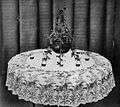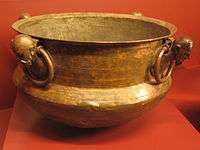Cauldron

A cauldron (or caldron) is a large metal pot (kettle) for cooking and/or boiling over an open fire, with a large mouth and frequently with an arc-shaped hanger.
Etymology
The word cauldron is first recorded in Middle English as caudroun (13th century). It was borrowed from Old Northern French or Anglo-Norman caudron[1] (Norman-Picard caudron, French chaudron). It represents the phonetical evolution of Vulgar Latin *caldario for Classical Latin caldārium "hot bath", that derives from cal(i)dus "hot".[1]
The Norman-French word replaces probably the not initial new English sentence ċetel (German (Koch)Kessel "cauldron", Dutch (kook)ketel "cauldron"), Middle English chetel. The word kettle comes from the Old Norse variant spelling ketill "cauldron".[2]
Symbolism and mythology

Cauldrons have largely fallen out of use in the developed world as cooking vessels. While still used for practical purposes, a more common association in Western culture is the cauldron's use in witchcraft—a cliché popularized by various works of fiction, such as Shakespeare's play Macbeth. In fiction, witches often prepare their potions in a cauldron. Also, in Irish folklore, a cauldron is purported to be where leprechauns keep their gold and treasure.
In some forms of Wicca, incorporating aspects of Celtic mythology, the cauldron is associated with the goddess Cerridwen. Welsh legend also tells of cauldrons that were useful to warring armies. In the second branch of the Mabinogi in the tale of Branwen, Daughter of Llŷr, the Pair Dadeni (Cauldron of Rebirth) is a magical cauldron in which dead warriors could be placed and then be returned to life, save that they lacked the power of speech.[3] It was suspected that they lacked souls. These warriors could go back into battle until they were killed again. In Wicca and some other forms of neopagan or pagan belief systems the cauldron is still used in magical practices. Most often a cauldron is made of cast iron and is used to burn loose incense on a charcoal disc, to make black salt (used in banishing rituals), for mixing herbs, or to burn petitions (paper with words of power or wishes written on them). Cauldrons symbolize not only the Goddess but also represent the womb (because it holds something) and on an altar it represents earth because it is a working tool. Cauldrons are often sold in New Age or "metaphysical" stores and may have various symbols of power inscribed on them.
The holy grail of Arthurian legend is sometimes referred to as a "cauldron", although traditionally the grail is thought of as a hand-held cup rather than the large pot that the word "cauldron" usually is used to mean. This may have resulted from the combination of the grail legend with earlier Celtic myths of magical cauldrons.
The common translation for ding is often referred to as a cauldron. In Chinese history and culture, possession of one or more ancient dings is often associated with power and dominion over the land. Therefore, the ding is often used as an implicit symbolism for power. The term "inquiring of the ding" (Chinese: 问鼎; pinyin: wèn dǐng) is often used interchangeably with the quest for power.
Archeologically intact actual cauldrons with apparent cultural symbolism include:
- the Gundestrup cauldron, made in the 2nd or 1st century BC, found at Gundestrup, Denmark
- a Bronze Age cauldron found at Hassle, Sweden
- the cauldron where the Olympic Flame burns for the duration of the Olympic Games
Cauldrons known only through myth and literature include:
Gallery
 A Witches'-caldron table
A Witches'-caldron table
.jpg) The Garden of Earthly Delights, bird-headed monster or the "Prince of Hell" (close-up head), a name derived from the cauldron he wears on his head.
The Garden of Earthly Delights, bird-headed monster or the "Prince of Hell" (close-up head), a name derived from the cauldron he wears on his head. Mušov cauldron. A Roman bronze cauldron found in 1988 in a Germanic chieftains grave in Mušov, Czech Republic dating to 2nd century AD.
Mušov cauldron. A Roman bronze cauldron found in 1988 in a Germanic chieftains grave in Mušov, Czech Republic dating to 2nd century AD. African American woman and child outdoors, standing by boiling cauldron of water, c. 1901.
African American woman and child outdoors, standing by boiling cauldron of water, c. 1901. Execution cauldron at Deventer (Netherlands)
Execution cauldron at Deventer (Netherlands)
See also
| Wikimedia Commons has media related to Cauldrons. |
| Look up cauldron in Wiktionary, the free dictionary. |
- Alfet
- Fire Pot
- Gulyásleves
- Hassle
- Kama (Japanese tea ceremony)
- Olympic flame
- Potjiekos
- Sacrificial tripod
References
- 1 2 T. F. Hoad, English Etymology, Oxford University Press, 1993 (ISBN 0-19-283098-8). p. 67.
- ↑ T. F. Hoad, English Etymology, Oxford University Press, 1993 (ISBN 0-19-283098-8) p.252.
- ↑ Davies, John; Jenkins, Nigel; Menna, Baines; Lynch, Peredur I., eds. (2008). The Welsh Academy Encyclopaedia of Wales. Cardiff: University of Wales Press. p. 129. ISBN 978-0-7083-1953-6.